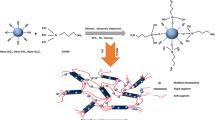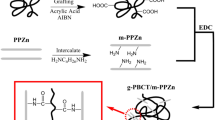Abstract
Efforts to develop and implement an increasing number of biodegradable polymers continue to grow worldwide; nevertheless, substantial obstacles must undoubtedly be surmounted in order to produce biodegradable polymers that exhibit exceptional properties and high performance. With the objective of enhancing the compatibility between the two intrinsically immiscible polymers, polybutylene adipate-co-terephthalate (PBAT) and poly(butylene adipate) (PLA), we employed epoxidized polyhedral oligomeric silsesquioxanes (epoxy-POSS) nanoparticles. A solution-casting method was employed to fabricate nanocomposites comprising a nanoparticle and two biocompatible polymers. This process proved to be highly effective. The distinctive morphology, high strength, toughness, and thermal stability of these nanocomposites were demonstrated by a variety of experiments at 1 wt% nanoparticle. The opposite effect was observed when nanoparticles were added exceeding 1 wt%; consequently, the degree of compatibility between the polymer phases diminished. The impact strength and elongation-at-break of the composite samples were significantly altered at 1% nanoparticle application, going from 57.04 MPa and 520% to about 400% and 62.4 MPa, respectively, as compared to pristine PLA. Microscopic observations showed that the dispersion of nanoparticles in all three phases was dispersed, continuous, and the interface was uniform, and the presence of nanoparticles prevented the melt crystallization of PLA.









Similar content being viewed by others
Change history
22 April 2024
A Correction to this paper has been published: https://doi.org/10.1007/s00289-024-05253-6
References
Muthuraj R, Misra M, Mohanty AK (2018) Biodegradable compatibilized polymer blends for packaging applications: A literature review. J Appl Polym Sci 135(24):45726
Ferreira FV et al (2019) An overview on properties and applications of poly (butylene adipate-co-terephthalate)–PBAT based composites. Polym Eng Sci 59(s2):E7–E15
Yin G-Z, Yang X-M (2020) Biodegradable polymers: a cure for the planet, but a long way to go. J Polym Res 27(2):38
Al-Itry R, Lamnawar K, Maazouz A (2012) Improvement of thermal stability, rheological and mechanical properties of PLA, PBAT and their blends by reactive extrusion with functionalized epoxy. Polym Degrad Stab 97(10):1898–1914
Chinsirikul W et al (2015) Flexible and tough poly (lactic acid) films for packaging applications: property and processability improvement by effective reactive blending. Packag Technol Sci 28(8):741–759
Fang G et al (2018) Femtosecond laser direct writing of 3D silica-like microstructure from hybrid epoxy cyclohexyl POSS. Adv Mater Technol 3(3):1700271
Bershtein V et al (2020) High performance multi-functional cyanate ester oligomer-based network and epoxy-POSS containing nanocomposites: structure, dynamics, and properties. Polym Compos 41(5):1900–1912
Yang H et al (2020) Epoxy-polyhedral oligomeric silsesquioxanes (POSS) nanocomposite vitrimers with high strength, toughness, and efficient relaxation. Giant 4:100035
Chen J et al (2021) Stable co-continuous PLA/PBAT blends compatibilized by interfacial stereocomplex crystallites: toward full biodegradable polymer blends with simultaneously enhanced mechanical properties and crystallization rates. Macromolecules 54(6):2852–2861
López-Rodríguez N et al (2006) Crystallization, morphology, and mechanical behavior of polylactide/poly (ε-caprolactone) blends. Polym Eng Sci 46(9):1299–1308
Luyt AS, Kelnar I (2019) Effect of blend ratio and nanofiller localization on the thermal degradation of graphite nanoplatelets-modified PLA/PCL. J Therm Anal Calorim 136(6):2373–2382
Agari Y et al (2007) Preparation and properties of the biodegradable graded blend of poly (L-lactic acid) and poly (ethylene oxide). J Polym Sci Part B Polym Phys 45(21):2972–2981
Li K et al (2011) Dynamic rheological behavior and morphology of polylactide/poly (butylenes adipate-co-terephthalate) blends with various composition ratios. Adv Polym Technol 30(2):150–157
Al-Itry R, Lamnawar K, Maazouz A (2014) Rheological, morphological, and interfacial properties of compatibilized PLA/PBAT blends. Rheol Acta 53(7):501–517
Aghjeh MR et al (2015) In depth analysis of micro-mechanism of mechanical property alternations in PLA/EVA/clay nanocomposites: a combined theoretical and experimental approach. Mater Des 88:1277–1289
Li Y, Shimizu H (2007) Toughening of polylactide by melt blending with a biodegradable poly (ether) urethane elastomer. Macromol Biosci 7(7):921–928
Li X et al (2018) The morphological, mechanical, rheological, and thermal properties of PLA/PBAT blown films with chain extender. Polym Adv Technol 29(6):1706–1717
Zhao F, Huang HX, Zhang SD (2015) Largely toughening biodegradable poly (lactic acid)/thermoplastic polyurethane blends by adding MDI. J Appl Polym Sci 132(48)
Lungu A, et al (2016) Polyhedral oligomeric silsesquioxanes nanoreinforced methacrylate/epoxy hybrids. J Appl Polym Sci 133(4)
Jaszkiewicz A et al (2014) Investigation of processability of chain-extended polylactides during melt processing - compounding conditions and polymer molecular structure. Macromol Mater Eng 299(3):307–318
Wang X et al (2019) Mechanical properties, rheological behaviors, and phase morphologies of high-toughness PLA/PBAT blends by in-situ reactive compatibilization. Compos B Eng 173:107028
da Silva JMF, Soares BG (2021) Epoxidized cardanol-based prepolymer as promising biobased compatibilizing agent for PLA/PBAT blends. Polym Testing 93:106889
Liu X et al (2023) Effect of biaxial stretching on the microstructure evolution, optical, mechanical and oxygen barrier properties of biodegradable poly (lactic acid)(PLA)/poly (butylene adipate-co-terephthalate)(PBAT) films. Int J Biol Macromol 253:126976
Paulsen E et al (2022) Use of PLA/PBAT stretch-cling film as an ecofriendly alternative for individual wrapping of broccoli heads. Sci Hortic 304:111260
Sun C et al (2022) Modified cellulose nanocrystals enhanced the compatibility between PLA and PBAT to prepare a multifunctional composite film. J Polym Environ 30(8):3139–3149
Kilic NT et al (2020) The Potential Use of Epoxy-POSS as a Reactive Hybrid Compatibilizers for PLA/PBAT Blends:“Effect of PBAT Molecular Weight and POSS Type.” Polym Eng Sci 60(2):398–413
Yazdaninia A et al (2016) Influence of trifluoropropyl-POSS nanoparticles on the microstructure, rheological, thermal and thermomechanical properties of PLA. RSC Adv 6(43):37149–37159
Ayandele E, Sarkar B, Alexandridis P (2012) Polyhedral oligomeric silsesquioxane (POSS)-containing polymer nanocomposites. Nanomaterials 2(4):445–475
Wang B et al (2020) Investigation on compatibility of PLA/PBAT blends modified by epoxy-terminated branched polymers through chemical micro-crosslinking. E-Polymers 20(1):39–54
Kumar M et al (2010) Effect of glycidyl methacrylate (GMA) on the thermal, mechanical and morphological property of biodegradable PLA/PBAT blend and its nanocomposites. Biores Technol 101(21):8406–8415
Qiu S et al (2021) Optimizing interfacial adhesion in PBAT/PLA nanocomposite for biodegradable packaging films. Food Chem 334:127487
Kilic NT et al (2019) Compatibilization of PLA/PBAT blends by using Epoxy-POSS. J Appl Polym Sci 136(12):47217
Han Y et al (2020) Improvement of compatibility and mechanical performances of PLA/PBAT composites with epoxidized soybean oil as compatibilizer. Ind Eng Chem Res 59(50):21779–21790
Su S, Duhme M, Kopitzky R (2020) Uncompatibilized PBAT/PLA blends: manufacturability, miscibility and properties. Materials 13(21):4897
Deng Y et al (2018) Optimising ductility of poly (lactic acid)/poly (butylene adipate-co-terephthalate) blends through co-continuous phase morphology. J Polym Environ 26:3802–3816
Arruda LC et al (2015) Influence of chain extender on mechanical, thermal and morphological properties of blown films of PLA/PBAT blends. Polym Testing 43:27–37
Di Lorenzo ML, Righetti MC (2018) Crystallization-induced formation of rigid amorphous fraction. Polym Cryst 1(2):e10023
Macosko CW (2000) Morphology development and control in immiscible polymer blends. In: Macromolecular Symposia. Wiley Online Library
Salehiyan R et al (2020) Effect of nanofillers characteristics and their selective localization on morphology development and rheological properties of melt-processed polylactide/poly (butylene adipate-co-terephthalate) blend composites. Polym Eng Sci 60(11):2749–2760
Yeh J-T et al (2009) Compatible and crystallization properties of poly(lactic acid)/poly(butylene adipate-co-terephthalate) blends. J Appl Polym Sci 116(2):680–687
Gigante V et al (2019) Rubber toughening of polylactic acid (PLA) with poly (butylene adipate-co-terephthalate)(PBAT): mechanical properties, fracture mechanics and analysis of ductile-to-brittle behavior while varying temperature and test speed. Eur Polym J 115:125–137
Al-Itry R, Lamnawar K, Maazouz A (2015) Biopolymer blends based on poly (lactic acid): shear and elongation rheology/structure/blowing process relationships. Polymers 7(5):939–962
Yeh JT et al (2010) Compatible and crystallization properties of poly (lactic acid)/poly (butylene adipate-co-terephthalate) blends. J Appl Polym Sci 116(2):680–687
Wu N, Zhang H (2017) Mechanical properties and phase morphology of super-tough PLA/PBAT/EMA-GMA multicomponent blends. Mater Lett 192:17–20
Dogan SK, et al (2014) Reactive compatibilization of PLA/TPU blends with a diisocyanate. J Appl Polym Sci 131(10)
Ethier JG et al (2019) Uniaxial deformation and crazing in glassy polymer-grafted nanoparticle ultrathin films. ACS Nano 13(11):12816–12829
Pan H et al (2018) The effect of MDI on the structure and mechanical properties of poly (lactic acid) and poly (butylene adipate-co-butylene terephthalate) blends. RSC Adv 8(9):4610–4623
Meyva-Zeybek Y, Kaynak C (2021) A comparative study for the behavior of 3D-printed and compression molded PLA/POSS nanocomposites. J Appl Polym Sci 138(16):50246
Author information
Authors and Affiliations
Corresponding author
Additional information
Publisher's Note
Springer Nature remains neutral with regard to jurisdictional claims in published maps and institutional affiliations.
The original online version of this article was revised: to correct the affiliation details for author Mozhdeh Madadi and author’s name Iman Salahshoori.
Rights and permissions
Springer Nature or its licensor (e.g. a society or other partner) holds exclusive rights to this article under a publishing agreement with the author(s) or other rightsholder(s); author self-archiving of the accepted manuscript version of this article is solely governed by the terms of such publishing agreement and applicable law.
About this article
Cite this article
Moradi, E., Madadi, M., Jaberi, N. et al. Poly(lactic acid)/poly(butylene adipate-co-terephthalate) films reinforced with polyhedral oligomeric silsesquioxane nanoparticles: a morphological, mechanical, and thermal study. Polym. Bull. (2024). https://doi.org/10.1007/s00289-024-05194-0
Received:
Revised:
Accepted:
Published:
DOI: https://doi.org/10.1007/s00289-024-05194-0




